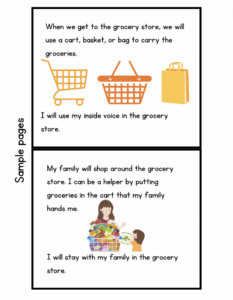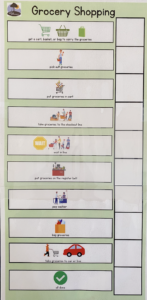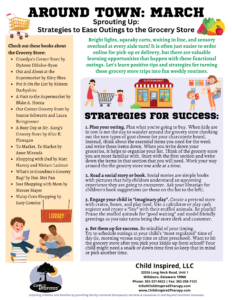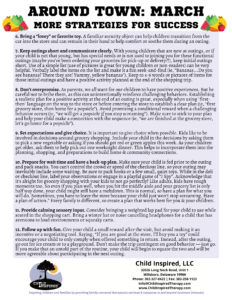Tips for Grocery Shopping with Children

There are many reasons why taking your child to the grocery store can be beneficial.
• Teaches reading, math, and other academic skills (letter and number identification, attributes, budgeting, decoding)
• Helps develop vocabulary
• Creates opportunity to practice social skills
• Exposes children to new foods
• Models healthy habits and opens conversation about nutrition
The life skills that grocery shopping can teach children are immense, but the reality is grocery shopping with kiddos can feel overwhelming. The first, second, third…even tenth time you take your child to the grocery store might be rough! This is normal! Consistent expectations and repeated exposure will help make grocery shopping with your kiddo less stressful. There are several strategies that can support successful, positive grocery shopping outings with children.
Step 1: Plan your outing
Think about the time of day that would be best to take your child to the grocery store. If you know your child’s nap time is approaching, it probably is not the best time to go. “There’s no perfect time to go grocery shopping with little ones, but aim for post-nap-time, so you have a well-rested baby.” (Brunswick Crossing) Want to hit the grocery store after you pick your kiddo up from school? Your child might need a snack and time to rest first so keep that in mind or pick another time.
Next, save time in the grocery store by planning what you’re going to buy. Today is not the day to wander around the grocery store checking out the new types of goat cheese for your charcuterie board. Instead, think about the items you need for the week, week night dinner, school lunches, breakfast, snacks, essentials, and write these items down. When you write down your groceries, it helps to organize your list. Think of the grocery store you are most familiar with. Start with the first section and write down the items in that section that you will need. Work your way around the the grocery store one aisle at a time. Most importantly, don’t forget that when you make your list that you check it twice! The more prepared you feel, the smoother things will go.
Lastly, pack the essentials: snacks, diapers, or a toy. “Grocery stores are full of hustle and bustle, which could overwhelm your child. To calm them down, pack your child’s favorite toy, blanket, book, or other item.” (Brunswick Crossing) Packing these items can also keep your child occupied which will help you get through the store more efficiently. Another way to keep your child occupied at the grocery store is by involving them in the grocery shopping! “Grocery stores have mini carts to make kids feel like Mom or Dad, which is a great way to incorporate them into the trip without dragging them aisle to aisle.” (Brunswick Crossing) Children of all ages can help with grocery shopping. Ask your child questions while grocery shopping, “what color is the apple?” or incorporate a game of I Spy “I spy the bananas”. Try putting your elementary-age child in charge of placing the items in the cart or checking items off the list.
Step 2: Keep outings short and communicate clearly
With young children that are new at outings, or if your child is not that young, but has special needs or is not used to joining you for these functional outings (maybe you’ve been ordering your groceries for pick-up or delivery since the pandemic?!), keep initial outings short. Use of a simple list (use of pictures is great for young children or non-readers) can be very helpful. Verbally label the items on the list and make it a fun seek-and-find (ie, “Bananas…Do you see bananas? There they are! Yummy, yellow bananas”). Keep to 4-6 words or pictures of items for those initial outings and have a positive activity at the end of the shopping trip. Use “first-then” language on the way to the store or before entering the store to establish a clear plan (ie, “first grocery store, then home for a popsicle”).
Step 3: Set expectations and give choice
Setting clear and consistent expectations for children helps them understand what is expected of them. Is your child asking you to buy their favorite treat or asking you to get them anything that looks of interest down every single aisle? “To avoid straying away from your grocery list, set limits to what they can and can’t have after completion of the grocery trip. Make sure they are using their manners, and no whining or begging.” (Brunswick Crossing)
Child Inspired has two simple tools to help children understand the expectations for going to the grocery store: Going to the Grocery Store Social Story AND Grocery Shopping Visual Sequence. Child Inspired’s Going to the Grocery Store Social Story is a customized social story for your child specific to their social needs or behavioral needs at the grocery store. Stories are told in the ‘first person’ with your child as the main character. These simple stories describe your child in a social situation (grocery store) and show how to act appropriately in that situation. Each book comes with laminated pages for durability and easy cleaning. This social story shows your child the expectations in the grocery store. 
Child Inspired’s Grocery Shopping Visual Sequence is a visual picture and word sequence of 1 specific routine for daily living or self-help tasks (grocery shopping). Visual sequences help break down the task into smaller chunks with a step-by-step approach to help develop independent routines. Each sequence is customized to your child’s routine. Each visual sequence is laminated for durability and is lightweight for easy posting/ hanging. This tool can help your child become a helper in the grocery store… making it easier on you!
Keep in mind, when giving expectations it is also important to give choice when possible. “Kids like to be involved in decisions around grocery shopping.” (Michele Oliver, Baby Foode) Include your child in the decisions by asking them to pick a new vegetable or asking if you should get red or green apples this week. As your children get older, ask them to help pick out one weeknight dinner. You can still keep your meals healthy by giving your child a cook book with meals you already know have nutritional value. This helps to incorporate them into the planning, shopping, and preparation process to build home and community connections.
Step 4: Have a back-up plan
Acknowledge that it’s alright for grocery shopping with your kids to not go perfectly! Like adults, kids have rough moments too. So even if you plan out everything, when you hit the middle aisle and your grocery list is only half way done, your toddler might still have a melt down. This is normal, so have a plan for what you will do. “Sometimes, you have to leave the store because your child just won’t stop screaming. However, if these hiccups do occur, have a plan of action.” (Brunswick Crossing) Every family is different, so create a plan that works best for you and your children.
Want to learn more tips and tricks? Join us March 19, 2024 from 11:00am-12:00pm at the Lewes Public Library for Tools for Tots: Grocery Store Outings. Immediately after Children’s Story Time, Child Inspired will lead a FREE workshop to learn healthy, developmentally-appropriate tips and strategies that will help little ones embark positively into community experiences “Around Town”. Child Inspired’s therapy team will provide information while children are invited to participate in a hands-on, learning activity themed to each month’s “Around Town” topic: March’s Topic- “Sprouting Up”: Strategies to Ease Outings to the Grocery Store. We hope to see you there!
Check out this handout of lots of great tips and strategies!


Authored by Lexi Gooch, Family Education Specialist
Child Inspired is an emerging family-centered, pediatric wellness practice in Southern Delaware . We are so proud of the inspiring group of pediatric therapists and educators that are working collaboratively to bring help and healing to children and families with in-home, outpatient therapy services and community outreach initiatives. The Child Inspired team takes their work very seriously, but does make sure to sprinkle in moments of silliness and laughter, as we all need strategies to cope with the various challenges we must navigate.
Thanks for being part of our community! We’d love to hear from you!

